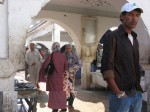Since independence from France in 1956, Morocco has been a magnet for writers, artists, backpackers and more recently, well-heeled tourists. Yet with street crime at record heights and few opportunities for the vast army of young, illiterate unemployed, and a monarchy that cares for little more than its survival, time may be running out for the North African kingdom to remain a top tourist destination.

Paul Bowles, Alan Ginsberg, William Burroughs. Never heard of them?
Try Brian Jones, Keith Richards or Jimi Hendrix, building castles made of sand?
Nothing that connects these people, springs to mind?
Well, I’m in Marrakech, the world’s coolest city.
That’s what the broadsheets all over Europe say, so it must be true. And perhaps this 12th century desert city in southern Morocco did hold the trump cards of cool for a while.
Following independence from France in 1956, the Beats, dysfunctional bohemian intellectuals from the Untied States, dropped by, lost themselves or simply tanked up on the Otherness of the place and wrote about it.
In the 1960s, the hippies boarded the Marrakesh Express, dropped out and tuned in to hashish and the majestic Atlas mountain range that rises out of the barren land to the south of the city.
By the late 60s, Rock and Rollers moved up the remote Atlas valleys in search of witchcraft, music, and drugs of course.
I first visited Marrakesh in the early 1990s. I fell in love with its mystery, its impenetrability, especially its sprawling medina, the old city of narrow alleys and fortress-like homes, and I have wanted to come back for years.
These days it’s fashionable for broadsheet journalists to confess to their youthful missteps and moral disorientation in tantalizing exotic locales and then to return, much later, as professional, well-paid wise-guys in order to ridicule the only times when they were ever truly alive. Then they tell us that the creative anarchy of the late 20th century has faded, the hippies and Beats, the poets and free spirits are long dead, that the world has turned a page. With its flash new hotels and spas, Morocco has finally been gentrified. Indeed it has. But not in the way anyone but the aforementioned hacks might have hoped for.
Now, the budget airlines for the mobile underclass fly to Marrakesh, disgorging tour-groups and wealthy graduates on dirty weekends onto Jemma El Fna, the main city square, a huge, truly amazing experience, crammed at night with thousands of performers, musicians, hustlers, food vendors and local spectators, celebrating the moment.
Dutchman Bert Flint arrived in Morocco shortly after independence, settled in Marrakesh, taught Spanish and began to investigate the cultural links between Southern Morocco and the African continent.
Today, his home, the Dar Tiskiwin in the Marrakesh medina, contains a celebrated exhibition of some of the artifacts, which Flint has collected over the years.

To Flint, Marrakesh was barely a town at all in the 1950s, “Marrakesh was a huge market and every day, about 25.000 people arrived and left, most of them on public buses. Jemma El Fna was the place where the buses stopped. That’s why all the performers and musicians were there. It was the heart of the city.”
But for a while, it looked like the square would have to make way for new developments.
“In 1956, the educated ruling class did not care for tradition. They wanted urban development and tried to get the square closed down. It was considered a dirty place, where a good family should never be seen. Only international pressure from historians changed the establishment’s mind. Now, the square is a tourist magnet and makes money, so objections have subsided. Yet it’s still very much the poor man’s cultural space.”
Independence had other consequences for Marrakesh.
“As soon as the French had left, the well-to-do Moroccans moved out of the medina. All those who could afford it moved into the villas of the French in the new part of town, which the former colonizers, in a rush to go home, sold cheaply. The medina became a ghetto of the poor.”
When I first marched into the Marrakesh medina, a sprawling labyrinth of alleys surrounded by a sixteen kilometer long mud wall, I was little more than a careless adventurer with no particular goal in life. I had little money and I was determined to invest it into reliving the good times of the above mentioned 20th century cultural icons.
I did. Within seconds, I was picked up by a gang of young men and ‘invited’ into an old house deep in the heart of the medina. In the courtyard, a solitary orange tree grew next to a small fountain. An old woman, hidden under a black chador, followed my unsoiled thoughts with black eyes. She looked older than the world itself. I soon found myself in a room with three young tough guys trying to sell me, besides the little hashish that I was after, heroin, cocaine and opium, or so they said. We got very stoned – clearly they wanted me vulnerable and paranoid. They also offered to sleep with me. They were friendly and threatening at once. I gave them all the cash I had and left, but not without swiping the hashish. Then I lost myself in the hundreds of alleys, shaking imaginary tails, avoiding imaginary police check points and eventually reaching my fleapit hotel profoundly happy and with a real sense of experience.

Today, the medina is no longer the exclusive ghetto of the poor. But it’s not the rich Moroccans who have moved back in. For wealthy Europeans, owning a Riad, a traditional home in the medina, is currently all the rage and in the last decade, foreigners seem to have bought up a large section of the old city. Once restored and equipped with modern amenities, the town houses serve as holiday homes or smart guest houses, and as many as 700 Riads are now said to be foreign hands.
Bert Flint chuckles, “Since the sale of the Riads began, many well-off families have tried to move back, following the tourist dollar.”
And now I am back too, with my wife and a moral compass: a completely different man to the one who’d walked into the Marrakesh medina all those years ago.
Guess what. Fundamentally, little has changed. The professional hacks who tell you so are too old to know better.
To be sure, the surface has changed. Jemma El Fna is now a UNESCO World Heritage Site, is lined with ATMs and has been retiled to provide access for the disabled. It takes a full five minutes before I am approached by a skinny youth, trying to sell me hashish, because the government has threatened anyone caught harassing tourists with time in jail.
But clearly, the kids don’t care about what their government says, because they are desperate. To Flint, the mass tourism Marrakesh has experienced in the last decade, has done little to make the city a better living space.
“I don’t even go out in the evening any more. There are so many unemployed youths out there, trying to trick the foreigners, that the medina has become a very aggressive space.”

The influx of new money on the one hand, and Morocco’s continued extreme poverty on the other, has led to plenty of development, little of it positive. While King Mohammed VI rules the country with less of an iron fist than his autocratic father Hassan II, under whose rule thousands of people disappeared, illiteracy is still higher than 50% and opportunities for young Moroccans are virtually zero. Unemployment touches almost 40% amongst the country’s youth. Drug abuse is wide-spread. This has led to significant problems between foreign visitors and locals.
Sue Hunt, a hotel owner in Essouira, a fishing town and former hippy bastion a couple of hours west of Marrakesh on the Atlantic coast, bemoans the current situation.
“The kids now hassle foreigners so much, that many of my guests tell me they will never come back to Morocco. Hotel owners have started many initiatives and held endless meetings to address the problem of street crime and hustle but without government help, there’s little we can do.”
Hunt, who fled from Zimbabwe to open her guest house in Essouira’s medina in 1999, still thinks the situation could be turned around.
“The government ran a series of adverts educating people about foreign guests. But it only ran for a couple of weeks. We need broader campaigns that last for several years before we will get any real results. In 2007, French visitor numbers dropped by 20%, simply because you can’t cross a street without someone trying to sell you something. And if you just give in a little, they take you all the way – everything is available, buy a little dope and you will be offered sex in the same breath.”
As unlikely as this may seem in a Muslim country, sex is available everywhere. The skinny young man who approached me on Jemma El Fna offered me girls in the same breath as the drugs. In fact, ever since the French left, Morocco has been the playground for rich Arabs, and more recently, for Western sex-patriates.
“Finding a girl, whether it’s an outright prostitute or a professional girlfriend, is no longer an issue in the cities. Nor is sex before marriage. Moroccans are extremely aware about what’s going on in Europe. Many have relatives in France.”
Old traditional values, it seems, are fast crumbling. This, in the current climate of fear and the United States’ War on Terror, could be dangerous. After all, in neighboring Algeria, the Islamic fundamentalists won an election in 1991 fair and square and were then barred from taking government, which led to a civil war that cost almost 200.000 lives. In 2000, hundreds of thousands of men and women demonstrated against more equality for women in the Moroccan coastal city of Casablanca, arguing that liberalization was imposed by the West.

Meanwhile, in restaurants and bars across Marrakesh, professional girlfriends party with overweight Europeans like there’s no tomorrow. As I sit on the rooftop of my Riad and watch a young Brit roll a joint, I realize that times may have changed, but that Morocco is every bit as corrupt, contradictory and seedy, as it was when Bowles, Ginsberg and Burroughs et al lived here.
Never trust a broadsheet hack when it comes to eternal truths. And, as far as I can tell, Marrakech is just one of those.
All images by Aroon Thaewchatturat.
Published in South East Globe and 2 Magazine.


Great article, especially the bit about the government campaign (or lack thereof) about how to treat tourists.